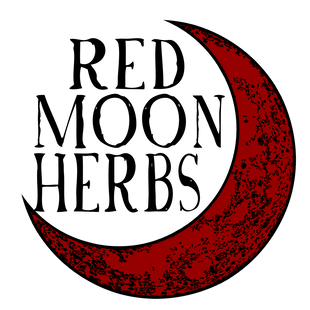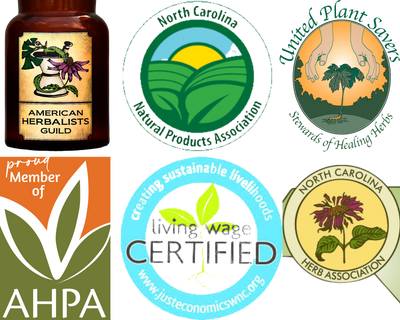Here at Red Moon, we have strived for over 20 years to carry on a rich tradition of locally wildcrafting much of the plant material that goes into our tinctures, tea blends, and dried herbs. While many herb companies may have started out wildcrafting their materials, they have quickly realized the true task of collecting plants from the wild: the wild is unforgiving, it is always in a state of flux, and it is never the same two years in a row. It resists management and it laughs in the face of quality control and harvest minimums.
Therefore, it is often easier to turn to cultivation, which can be dependable, regulated, and predictable. But we have stayed true to our course as wildcrafters, true to the Wise Woman Tradition, and true to those wild plants which can be so much more potent than their cultivated varieties. But why, when the challenge of the wild is so much steeper?

Wildcrafting for the Planet
When we wildcraft in conscious relationship with the ecosystem, we actually work to improve the robustness of the flora and fauna in that environment even as we boost our own health. By gathering the bounty of the wild around us, we encourage the plants to continue blooming, and bloom prolifically: more, faster, longer than before. When we get a haircut, the fibers of our hair react by growing more vigorously and robustly than before; when we prune a vitex bush or wildcraft the bark of a cherry tree’s limbs for its benefits, the plant responds by growing faster and producing more buds, blooms, and those incredible phytochemicals – flavonoids, polysaccharides, and alkaloids – that we call health-affirming.
As wildcrafters, we strive to always familiarize ourselves with the mini ecosystem around us before a harvest. When I go out to gather red clover or nettles to dry for infusions, I remember that these are food herbs for the bees, deer, and rabbits who live in that field or creekbed. Just as they are food herbs for us, bringing us nourishment in the form of proteins, minerals, and vitamins, they are also a major part of the diet for wildlife foragers.
The one-in-three principle is a good rule of thumb to keep in mind. Harvest one, leave two to grow. Take one out of every three blossoms, buds, or berries. While this rule applies to plant populations that are growing in abundance, the rule shifts to one-in-ten among herbs that are rarer or take longer to grow and establish themselves. In reality, there is no clean this-for-that rule when wildcrafting. It is a matter of knowing your ecosystem, the needs of the flora and fauna in it, and the way those species interact with the plant you are harvesting. Always check with resources like United Plant Savers to tell if a plant is rare, threatened, or endangered before harvesting it.
Wildcrafting for Our Physical Health
The superior nutritional and beneficial properties of wildcrafted plants, versus their cultivated counterparts, are well documented. According to a New York Times article on the subject, we are effectively “breeding the nutrition out of our food” the further our cultivated varieties of produce get from their wild origins. Apples have become progressively sweeter over time, as have most fruits, evolving with our sugar-loving taste buds. Fresh cultivated vegetables, even those that are organically grown, have become less potent due to our manipulation of the bitter beneficial alkaloids out of them.
These bitter constituents that are so prevalent in wild food, however, are one of the primary helpful tonics for organs like the liver and the gallbladder. Digestion is a process that relies on the body’s creation of food-appropriate enzymes that only occurs when food is properly tasted. The bitter components of wild plants help our digestive organs to recognize these foods and produce these enzymes that help us to maximize the nutrition that we derive from them. It is no wonder that a bunch of wild dandelion greens, bitter as they may be, brims with far more nutrition, vitamins, and trace minerals, than even the most beautifully grown organic kale. Frank Cook, renowned naturalist, ethnobotanist, and wild foods educator, told us to ‘Eat something wild every day’. This advice, if carried out, goes straight to the liver.

Spending time in nature – whether wildcrafting, walking, or simply wandering – also comes with a slew of health benefits that are undeniable. Lifespans are at an all-time high (at least for the modern world) and those who spend more time outdoors are more likely to be able to live that lengthy life to its fullest and longest, according to research done by the Journal of Aging Health. Their study found that the seniors who went outside each day complained less about sleeping issues and aching bones, among other things, than those who did not. This increase in lifespans may be due to several factors of spending time in the natural world, including: reduction in stress, increased feelings of happiness and contentment, improved health of the lungs and bloodstream because of exposure to clean air, vitamin D exposure, or lowered blood pressure because of reduced anxiety.
The opposite of spending time outdoors has been termed “nature deprivation” and is linked to massive amounts of screen time in front of TVs and computers. This screen time overload is related to increased risk of death, according to research by the Journal of the American College of Cardiology. On the contrary, people who spend time in nature may live longer than those who do not. Over five years, a Japanese study was conducted among senior citizens which concluded that those who had accessible, walkable green space were more likely to live longer than those who didn’t. Another study showed that hospital patients exposed to plants expressed lower blood pressure and heart rate, lessened pain and reduced anxiety. It has been proven in several studies that the elderly who spend time outside experience reduced blood pressure, allowing them to prolong their life. If this is what happens by just bringing plants into a room, imagine what happens when people are brought into a whole wondrous landscape of plants to wildcraft them for their helpful benefits and for food!
Forest bathing, a term that has been created to reference people spending time in nature and receiving healing benefits from it, is a side effect of wildcrafting. It refers to the act or the art of spending quality time, unplugged, in a forested setting and simply witnessing the beauty of that world. While you are likely to get more dirty than clean, it is the good kind of dirt, the kind of soul-dirt that fills us and satisfies us and permeates our vision. Those who ‘forest bathe’, or whatever your version of that is, have been documented to live longer, have less stress, and are able to fight off cancer more effectively, according to a number of clinical journals.
Wildcrafting for the Soul

But does it go to the soul, too?
As we have seen, the evidence says yes, in many ways and in many languages, both scientific and anecdotal. Wildcrafting and basking in the outdoors nourishes our souls in ways that unspeakable, but universally acknowledged. We connect with wild plants in a way that is carried forth to us in our blood, in our genetics, in our fingerprints. Plants have always been our life source and life force, and when we gather them in their natural habitats we are returning, if ever so briefly, to a moment in our ancestry when we needed them for sustenance, when they were our primary form of health care, and when we were helpless without their generous nourishment.
We wildcraft because we must, we wildcraft because it is part and parcel of our genetic heritage, and we wildcraft to further forge our relationship with the gifts of the wild outdoors and the wild within all of us. So when you see the word ‘wildcrafted’ on one of our labels, you will know that herb originated in the remote hills and valleys of Appalachia, was bartered for with bears and wild boars, and comes from a heart place of primitive connection between our hands and the untamed land of our ancestors.







